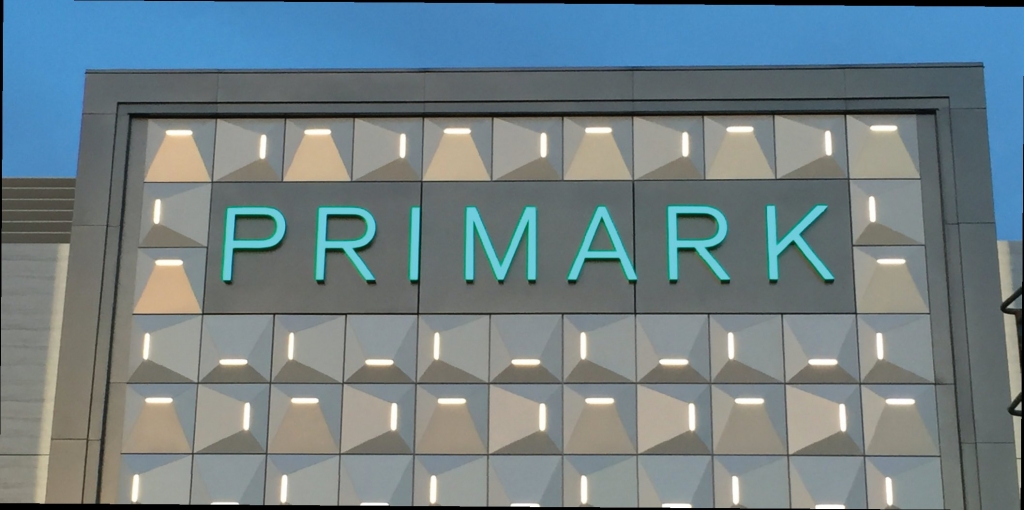Many department stores’ signage and environmental graphics are so predictable that some visitors – especially devout shopaholics – could navigate a store blindfolded. Mall patronage has declined considerably in recent years; according to Piper Jaffray & Co.’s research, only 8% of women shopped weekly in spring 2015, a more than 50% drop from spring of the previous year. And, although consumer preferences have gravitated towards open-air retail developments – and diminishing disposable income may have shrunk the pool of shoppers for which retailers compete — a lack of captivating signage also blunts consumer enthusiasm.
Thankfully, enlightened retailers understand that making money requires spending money, which entails implementing quality environmental graphics with equal vigor as recruiting quality personnel and offering quality merchandise. Primark, an Irish-based retailer, offers cut-rate merchandise because, according to its website, it eschews big-money advertising, purchases in bulk from suppliers and maintains efficient production and distribution methods.
Primark’s on-premises signage and graphics reflect the company’s investment in its brand identity. Primark’s U.S. project manager, LOLA Creative Solutions, contacted Ruggles Sign, a Versailles, KY-based sign company that specializes in retail signage, about the project, and recommended the company to Primark executives.
John Fitch, Ruggles’ project manager for the Primark campaign, noted that Primark practices swift inventory turnover. In addition to minimizing warehousing expenses, it also creates a trendy image. As such, he said the client emphasizes cutting-edge signage, with “innovative approaches to shapes and materials.”
Tim Cambron, who owns the company with his wife, Anna, said, “One thing that sets Primark’s sign package apart from others is a complete investment in its branding, which extends all the way to the back of the house.”
Fitch said Primark’s comprehensive environmental-graphic program was rolled out at its first U.S. store in Boston, which opened in early September. Ruggles completed its design with CorelDRAW and SA Intl. FlexiSign programs. For the second store, which opened the day before Thanksgiving in King of Prussia, PA, in suburban Philadelphia, he said the shop was able to provide fabrication input.
The first Primark location occupied the former Filene’s Basement, a venerated Beantown store that closed in 2011 after more than a century in operation. Fitch said Primark strived to develop décor and signage that restored the erstwhile Filene’s Basement ambience. He said, “The Boston store presented challenges for installing exposed-neon signage that Primark wanted. So, our shop built drywall sheets that were prefitted with wiring and fittings that accommodated luminous tubing and its transformers. The luminous tubing comprises 8, 10 and 12mm Seacrest glass, and was powered with 9,000V/30mA transformers.
Ruggles transformed the Filene’s building’s structural I-beams into a neon-lit, wayfinding feature. The shop fabricated a 2-in.-thick, faux-finished, aluminum-tube structure mounted from floor to ceiling inside a glass enclosure that house the exposed-neon, floor-ID numerals. To replicate old-style neon wiring, the shop created cloth fake cord that concealed the real wiring. Ruggles enlivened the elevator directories with 0.090- and 0.125-in.-thick, aluminum cabinet signs formed on the shop’s MultiCam CNC router and decorated with a hand-decorated, custom-formulated faux-finish.
Some department-store-ID brass signs feature bottom and middle layers bearing a brushed finish, with a polished tier atop them. Each layer was slightly inset from the one beneath to create a stair-step appearance. Installers attached the assemblages to an underlying acrylic layer, and they were then secured to integral fixtures. Primark’s other departments utilize a series of geometrically shaped markers, which were formed on the MultiCam table, and secured atop a series of criss-cross support arms built from a custom jig that allowed precise assembly and modular, repeatable construction.
Outside the King of Prussia store, the largest sign measures 54 in. tall, and features RGB LEDs that, to create brightness that pops, are populated four times greater than manufacturer recommendations. The signs enjoy a backdrop of a grid-shaped encasement with a random pattern of light bars that provides an eye-catching effect. Ruggles coupled the modules with custom-fabricated, blue-acrylic faces secured to opal-blue-colored acrylic with clear glue that allows Primark’s signature, azure shade to shine prominently.
“The sphere-covered, departmental signs were the project’s biggest challenge,” Fitch said. “The spheres had to be lightweight, of differing diameters and mounted at various distances away from the signface. So, these required careful consideration before fabrication. Also, they were created to European electrical standards, and we had to share with them the UL-listing specifications and other code requirements, which limited the type of LEDs we could use and the type of wiring that’s permitted.”
He said, “We had a little bit of a learning experience with meeting Primark’s expectations with the first store, but this made the second store’s fabrication process that much smoother.”



 Tip Sheet1 week ago
Tip Sheet1 week ago
 Photo Gallery3 days ago
Photo Gallery3 days ago
 Ask Signs of the Times5 days ago
Ask Signs of the Times5 days ago
 Real Deal2 weeks ago
Real Deal2 weeks ago
 Benchmarks1 week ago
Benchmarks1 week ago
 Photo Gallery10 hours ago
Photo Gallery10 hours ago
 Women in Signs2 weeks ago
Women in Signs2 weeks ago
 Paula Fargo10 hours ago
Paula Fargo10 hours ago







